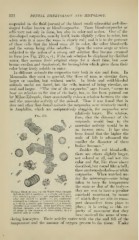Page 522 - My FlipBook
P. 522
532 DENTAL EMBRYOLOGY AND HISTOLOGY. ;; —
suspended in the fluid (serum) of the blood small spheroidal and disc-
shaped bodies known as blood-corpuscles. These blood-corpuscles or
cells vary not only in form, but also in color and action. One of the
disc-shaped corpuscles, seen by itself, looks slightly yellow in color, but
when seen in a mass the mass is clearly red ; and it is to the presence
of these cells that the blood owes all its color, the other blood-cells
and the serum being alike colorless. Upon the warm stage or when
subjected to the action of a strong salt solution they become crenated
in form (see Fig. 270, c, c) ; if the salt solution be displaced by distilled
water, they assume their original shape for a short time, but soon
bcome swollen and decolorized, the luemoglobin which gives them their
color being freely soluble in water.
In different animals the corpuscles vary both in size and form. In
Mammalia they exist in general, like those of man, as circular discs,
larger or smaller, but without nuclei. In birds and cold-blooded
animals nuclei are found, but the cells, instead of being circular, are
oval and larger. " The size of the corpuscles," says Foster, " seems to
bear no relation to the size of the body, but, as has been pointed out
by Milne-Edwards, there occasionally exists a relation between the size
and the muscular activity of the animal. Thus it was found that in
deer and other fleet-footed animals the corpuscles were relatively small
in Amphibia, which are comparatively sluggish, the corpuscles were
relatively larger. The relation,
FiC4. 270.
then, that the diameter of the
corpuscle would bear to the
muscular activity would be in
an inverse ratio. It has also
been found that the higher the
scale of life is advanced the
smaller the diameter of these
bodies becomes."
Besides the red blood-cells,
there are others slightly larger,
not colored at all, and not cir-
cular and flat, like those above
described, but round like a ball
these are termed colorless or white
corpuscles. When watched un-
der the microscope—care being
taken to keep the temperature
the same as that of the body
they are seen to have a peculiar
Human Blood as seen on the Warm Stage (magni-
fied abuut I'-'OO diiuneters) : r, r, single led corpus- amoeboid movement, by means
cles seen lying flat; r', r', red corpuscles on their
edge and viewed in profile; r", red corpuscies of which they are able to trans-
arranged in rouleaux; r, r,creiiate red corpuscles;
;<, a finely granular pale corp\iscle ; (/, a coarsely port themselves from place to
granular'pale corpuscle. Hoth have two O' three place; is owing to this ca-
distinct vacuoles, and were undergoing changes it
of shape at the moment of observation ; iu 1/ a pacity of movement that they
nucleus also is visible.
have received the name of wan-
dering leucocytes. Their activity varies with the rise and fall of the
temperature and the amount of oxygen present in the tissue. Under


